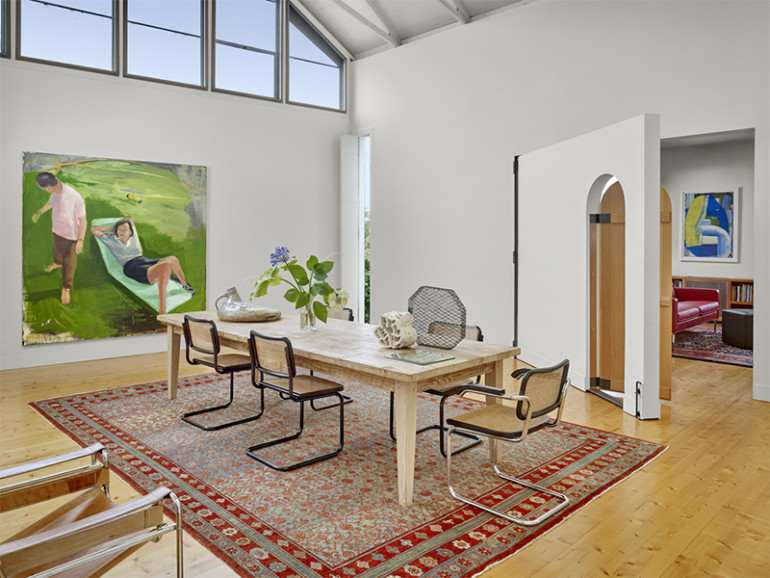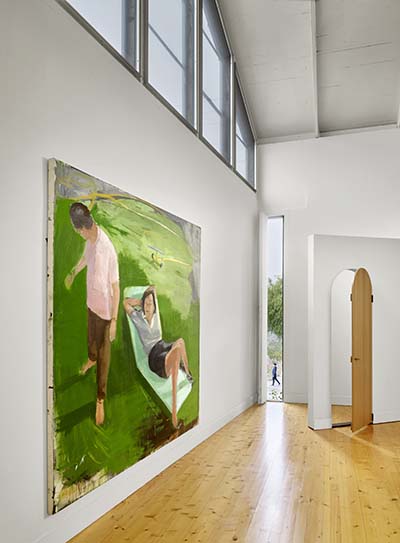 THE SKYROCKETING COST of rent has created an exodus — or expulsion — of artists from San Francisco to the East Bay that hasn’t been stemmed for nearly two decades now.
THE SKYROCKETING COST of rent has created an exodus — or expulsion — of artists from San Francisco to the East Bay that hasn’t been stemmed for nearly two decades now.
However, painter Christopher Brown, whose reputation as an artist blossomed in the Bay Area during the mid-1980s, was one of the lucky ones who years ago chose Oakland (when he was a graduate student at UC Davis) and later Berkeley, where he has lived and worked for three decades.
Brown presciently seized the opportunity to partner with fellow artist Catherine Alden, a sculptor, to build his home and studio in an industrial section of Berkeley called Ocean View.
Ceramicist Peter Voulkos worked on his sculptures in a loft close by, but the area was otherwise desolate; today’s vibrant shops, galleries and restaurants on nearby Fourth Street would have been inconceivable.
“Catherine had purchased an empty lot and we designed a pair of condominiums together,” Brown says. “It was easy. I gave my drawings to an architect who made it buildable.”
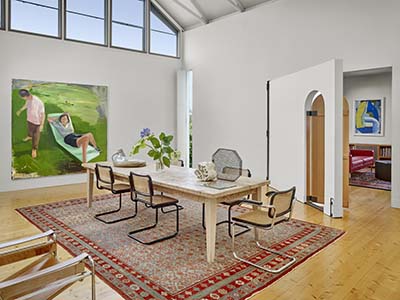 Brown had been teaching at UC Berkeley and had saved enough not only to pay for his half of the 6,000-square-foot property but also the construction costs, which all came to an affordable $350,000.
Brown had been teaching at UC Berkeley and had saved enough not only to pay for his half of the 6,000-square-foot property but also the construction costs, which all came to an affordable $350,000.
The two-story 5,500-square-foot live/work wood-frame building they created suited them perfectly. Their asymmetrical units were conjoined and had two floors each, “but I had more of the top floor because I needed light and she needed most of the stable ground floor for her sculptures,” Brown says.
The industrial zoning allowed leeway in choice of materials, and low-maintenance corrugated galvanized-steel cladding for the exterior was a top pick — well ahead of the current vogue — because “steel was cheap then, and it was beautiful,” Brown says. To complement it, the front door was painted a cheerful red.
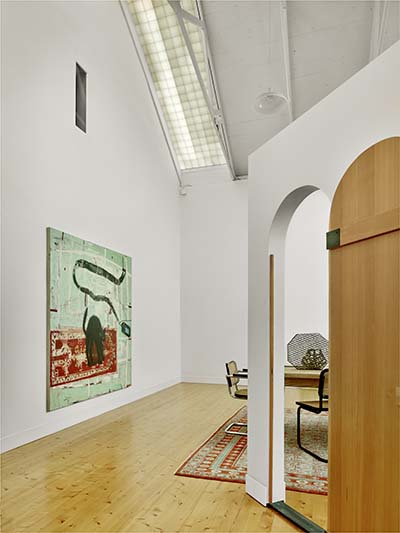 They also kept interior details basic until they could afford improvements. Plywood floors were eventually covered with spruce planks and, to save money, Brown built himself much-needed kitchen cabinets and shelving for books.
They also kept interior details basic until they could afford improvements. Plywood floors were eventually covered with spruce planks and, to save money, Brown built himself much-needed kitchen cabinets and shelving for books.
His roughly square-shaped main floor upstairs was divided equally for living and working. “Both sections were about 20 by 40 feet on each side of the stairs coming up from my street-level 500-square-foot storage space,” Brown says. A kitchen and small living space with a loft bedroom took up one side, and, left of the stairs, the painting studio — where Brown worked on his bestknown images inspired by Civil War themes and other historic material such as the Gettysburg Address, JFK’s assassination and footage from the silent film Battleship Potemkin — was an 18-foot-high gabled loft space with translucent skylights, large clerestory windows on the north side for even light, and a windowless west wall against which he liked to lean large canvases. A tall, narrow window cut into a corner of the east wall allowed the artist to slip finished works out onto delivery trucks headed to galleries.
Now that Brown has a separate studio at another location in Berkeley where he paints every day, a section of the home studio has been absorbed into the living space. The rest remains as it was, serving as an office and a gallery for large paintings he has saved for himself.
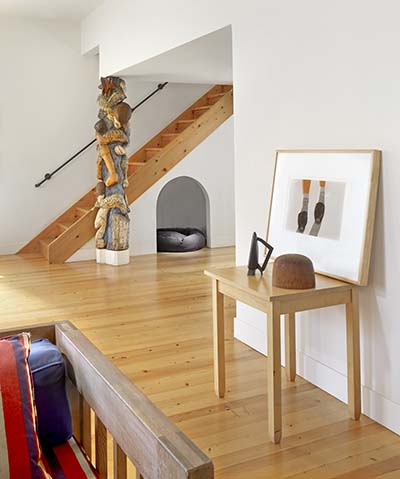 “For many years this home studio sat empty and I used it only as a drawing space,” the prolific artist recalls. With the original dividing wall between it and the living area gone, Brown considered adding a new partition to separate the cavernous gallery from the enlarged living room — mainly to keep heat contained — but decided instead on an alternative: a hinged wall that could be moved at will.
“For many years this home studio sat empty and I used it only as a drawing space,” the prolific artist recalls. With the original dividing wall between it and the living area gone, Brown considered adding a new partition to separate the cavernous gallery from the enlarged living room — mainly to keep heat contained — but decided instead on an alternative: a hinged wall that could be moved at will.
“I did not want a fixed wall there because I had become fond of the open space. As it happened, I had just been to Morocco, where large gates have smaller arched doors within them for one person to pass through, and I copied that,” Brown says. “I can close off the studio room when I want, and when I need to go in there, I just use the small door.”
The wall/gate has an ingenious hinge crafted by steel smith Larry Brown with an angled fin and a roller on the underside to help support its weight.
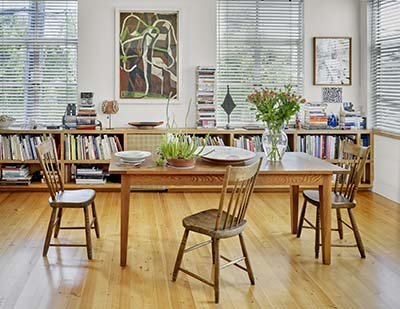 While the cozy living space holds an ever-changing collage — of books, a collection of baseball mitts, old and new artworks by Brown as well as from friends and students, objects he’s collected from local galleries, and furniture he has either built or gathered, including a table and chairs he used as a child in his parents’ home — the bright studio/gallery is still sparse.
While the cozy living space holds an ever-changing collage — of books, a collection of baseball mitts, old and new artworks by Brown as well as from friends and students, objects he’s collected from local galleries, and furniture he has either built or gathered, including a table and chairs he used as a child in his parents’ home — the bright studio/gallery is still sparse.
“I did like having my studio in the house,” he muses. “It was nice when I stopped working each day that I could return to it immediately the next morning to review my work. That’s why I may paint here again.”
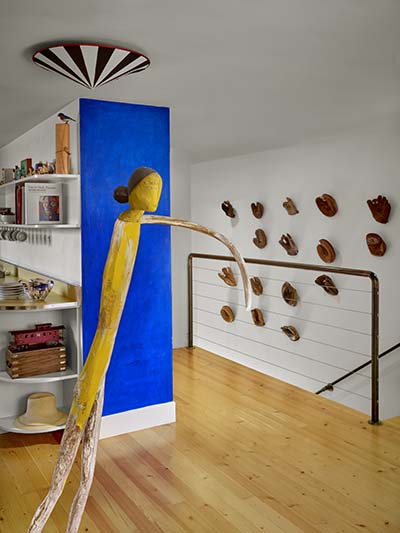 For the moment, it has a large Persian rug and a long dining table, which Brown originally built for rolling out canvases, that now doubles as a desk. On the walls at each end of the table are large canvas self-portraits from the late ’90s when he lived briefly in New York. “One is conventional and figurative, and the other is more playful and cartoonish,” he says. Nonetheless, the broad-brush painterly style links the pieces to works by Bay Area Figurative movement artists David Park, Elmer Bischoff and Richard Diebenkorn, all artists who influenced Brown.
For the moment, it has a large Persian rug and a long dining table, which Brown originally built for rolling out canvases, that now doubles as a desk. On the walls at each end of the table are large canvas self-portraits from the late ’90s when he lived briefly in New York. “One is conventional and figurative, and the other is more playful and cartoonish,” he says. Nonetheless, the broad-brush painterly style links the pieces to works by Bay Area Figurative movement artists David Park, Elmer Bischoff and Richard Diebenkorn, all artists who influenced Brown.
“I was always a figurative painter,” Brown says. “It started with my Midwestern roots in Ohio. In Chicago, Illinois, where I went to university, there is a long tradition of figurative painting. People are drawn to figures because they are accessible and recognizable.”
At art school in Davis, Brown had painters Wayne Thiebaud and Roy De Forest and sculptors Robert Arneson and Manuel Neri as mentors. “Artist Jim Melchert was my colleague at Berkeley, where I taught until 1994,” he adds.
“There was a moment when those great artists converged,” Brown says. “And, I just happened to be in this area.”
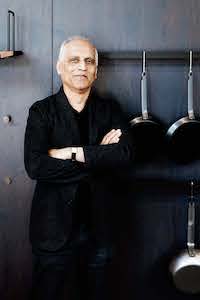
Zahid Sardar brings an extensive range of design interests and keen knowledge of Bay Area design culture to SPACES magazine. He is a San Francisco editor, curator and author specializing in global architecture, interiors, landscape and industrial design. His work has appeared in numerous design publications as well as the San Francisco Chronicle for which he served as an influential design editor for 22 years. Sardar serves on the San Francisco Decorator Showcase design advisory board.

